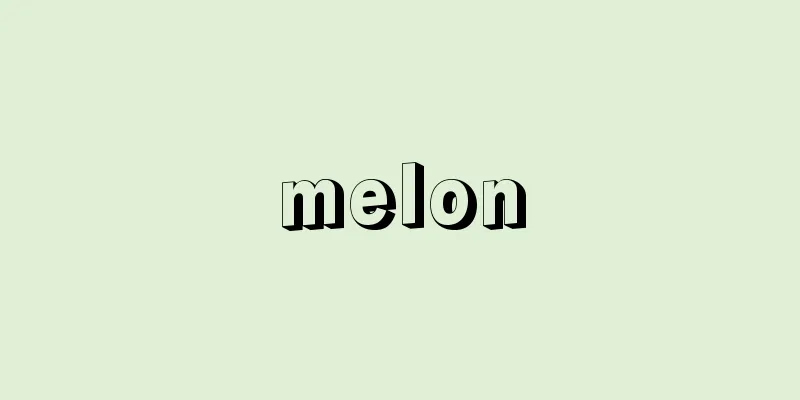Flat glass - Itagarasu (English spelling) Flat glass

|
A general term for glass products made into plates of uniform thickness. There are many types, such as colored ones, ones with a surface coating, ones with curved surfaces, ones with uneven patterns, ones made of two or more layers, ones that have been tempered, etc., and they are widely used for windows in buildings and transportation, doors and partitions, showcases, greenhouses, mirrors, etc. In terms of composition, it is a type of soda lime glass. [Teruo Sakaino and Setsuro Ito] Manufacturing methodNowadays, most glass is produced by the float process. The raw materials are silica sand, soda ash (sodium carbonate), limestone, dolomite, feldspar, and saltwater (sodium sulfate), mixed with cullet (glass waste). These raw materials are placed in a melting furnace with a capacity of 1000 tons or more and continuously melted at a high temperature of over 1500°C to produce a homogeneous molten liquid. The molten liquid is then introduced into a float bath filled with molten metal, floated in a strip on the surface of the molten metal, and while gradually cooling, it is continuously drawn into an annealing furnace and cut into sheet glass. Tin, which has a low melting point, is used as the molten metal, and the semi-melted sheet glass floating on the surface becomes highly smooth and flat by the time it reaches the annealing furnace, so it can be used for high-quality mirrors without polishing. Wire-reinforced sheet glass is produced continuously by inserting a metal wire into the molten liquid flowing out of the melting furnace when it is shaped into a sheet by a pair of rollers. Patterned sheet glass can also be produced by using a pair of rollers with a pattern engraved on one side. The smoothness of the glass surface that comes into contact with the roller is poor, so it is polished as necessary to produce the finished product. [Teruo Sakaino and Setsuro Ito] Type and UseThe most common type of glass is plain, and is produced in thicknesses between 2 and 25 mm, but it can be made thinner or thicker. Usually, glass is colorless and transparent, but impurities such as iron give it a slight bluish-green color. On the other hand, various colored glass is produced by intentionally dissolving colorants into the glass. Wired glass does not easily crumble even if it breaks, is fireproof, and has advantages in crime prevention and earthquake resistance, so it is widely used in buildings. Double-glazed glass is made by sealing two or more sheets of glass with a thin layer of rare gas or vacuum between them, and is suitable for energy saving purposes such as cooling and heating because of its insulating effect, and also has a high soundproofing effect. Grooved glass, also called profilite, is a shallow U-shaped column that is interlocked to create a light-gathering wall. It is translucent because the molten glass is formed with rollers, and wired glass is also produced. Colored glass is made by painting and baking ceramic pigments on one side of the glass. It comes in many different colors and is used for interior decoration and for the decoration of rear windows of automobiles. Conductive glass is made by coating the glass surface with a transparent conductive thin film, embedding thin heating wires in the middle layer of laminated glass, or baking conductive materials on the glass surface in the form of lines. It is used as a substrate for electronic devices, a substrate for solar cells, and window glass to prevent condensation and freezing in buildings and vehicles. In the past, most mirrors were made from polished thick glass, but nowadays, float-processed glass is used as is, plated with silver and then copper-plated for protection to create a mirror finish. In addition, there is also processed glass in which patterns are engraved on the surface of the glass by sandblasting (a method of removing the surface layer by spraying abrasives such as silica sand or metal powder with compressed air) or corrosive acid. [Teruo Sakaino and Setsuro Ito] [Reference item] | |©Shogakukan "> Flat glass manufacturing process (float process) ©Shogakukan "> Types of flat glass products ©Shogakukan "> Average light transmittance of transparent plate glass (approximate value) Source: Shogakukan Encyclopedia Nipponica About Encyclopedia Nipponica Information | Legend |
|
均一な厚みの板状につくられたガラス製品の総称。着色したもの、表面コーティングをしたもの、曲面のもの、凹凸の模様のあるもの、2枚以上重ねたもの、強化処理したものなど多くの種類があり、建築物や交通機関の窓、ドアや間仕切り、ショーケース、温室、鏡などに広く使われている。組成的にはソーダ石灰ガラス(ソーダライムガラス)の一種。 [境野照雄・伊藤節郎] 製法現在では、ほとんどがフロート法によって製造されている。原料は、珪砂(けいさ)、ソーダ灰(炭酸ナトリウム)、石灰石、苦灰石、長石、ボウ硝(硫酸ナトリウム)等で、これにカレット(ガラスくず)を混ぜたものである。この原料を容量1000トン以上の溶融炉に入れ1500℃以上の高温で連続的に溶かして均質な融液とした後、溶融金属を満たしたフロートバスにその融液を導き、溶融金属表面上に帯状に浮かべ徐々に冷却しながら連続的に徐冷炉へ引き出し、切断して板ガラスとする。溶融金属には融点の低いスズを用い、この表面に浮かぶ半融状態の板状ガラスは徐冷炉に達するまでに高い平滑度と平面性をもつようになるので、研摩することなしに高級な鏡にも利用できる。網(線)入り板ガラスは、溶融炉から流出した融液を1対のローラーで板状に成形するとき、同時に金属網(線)を挿入して連続的に製造し、また1対のうち片方に模様を刻んだローラーを使えば型板ガラスができる。ローラーに触れたガラス表面の平滑度は悪いので、必要に応じ研摩して製品とする。 [境野照雄・伊藤節郎] 種類・用途もっとも多く使われるのは無地の板ガラスで、2ミリメートルから25ミリメートルの厚さのものが生産されているが、さらに薄いものも厚いものもつくることができる。通常、ガラスは無色透明であるが、不純物の鉄の着色によりわずかに青緑色を呈する。一方、意図的に着色剤をガラス中に溶かし込み各種の着色ガラスがつくられている。網(線)入り板ガラスは割れてもたやすくは崩れ落ちず、防火性があり、また防犯、耐震上有利なので、ビルディングなどに用途が広い。複層ガラスは、2枚以上の板ガラスを希ガスや真空の薄い層を挟んで密封したもので、断熱効果があるため冷房や暖房の省エネルギーの目的などに適しており、また遮音効果も高い。溝型ガラスはプロフィリットともよばれ、浅いコの字型の柱状で、これをかみ合わせて採光式の壁面とする。溶融ガラスをローラーで成形するので半透明であり、線入りのものも生産されている。色焼き付けガラスはセラミック顔料を片面に塗布して焼き付けたもので、着色の種類が多く、室内装飾や自動車用後部ガラスの装飾などに用いられる。また、導電性ガラスは、ガラス表面に透明な導電性薄膜をコーティングする、合わせガラスの中間層に細い発熱線を埋め込む、ガラス表面に導電性物質を線状に焼き付ける、などの加工によって通電・発熱の機能をもたせたもので、エレクトロニクス素子の基板、太陽電池基板、建築物や車両の結露・凍結防止用窓ガラスに利用されている。以前は大部分の鏡には厚板ガラスを研摩して用いたが、現在はフロート法による板ガラスをそのまま利用し、これに銀めっき、その上に保護のため銅めっきを施して鏡面にしている。これらのほか、板ガラスの表面にサンドブラスト法(高圧空気と一緒に珪砂(サンド)や金属粉などの研磨剤を吹き付けて表層を除去する方法)や腐食性酸などで模様を刻みつける加工ガラスもある。 [境野照雄・伊藤節郎] [参照項目] | |©Shogakukan"> 板ガラスの製造工程(フロート法) ©Shogakukan"> 板ガラス製品の種類 ©Shogakukan"> 透明板ガラスの平均光線透過率(概略値) 出典 小学館 日本大百科全書(ニッポニカ)日本大百科全書(ニッポニカ)について 情報 | 凡例 |
<<: Itháki Island (English spelling)
>>: Cardboard - Itagami (English spelling) cardboard
Recommend
Inarticulata
… [Extant species] There are about 100 genera of ...
apathy
... refers broadly to an indifferent attitude tow...
Anion exchange membrane
… Ion exchange resins in the form of membranes ar...
white
…In France, Babeuf had already opened up the theo...
Oshima stone
A type of granite produced on Oshima Island in the...
《Camerawork》 - Kamerawork
...No matter how pictorial a photograph may be, t...
The School of Victory
→ Vaisheshika school Source: Shogakukan Encyclope...
hetoimasia
...The former are, for example, the Virgin and Ch...
recurrentdislocation
...Repeated dislocations may progress to habitual...
Temperature - Kion
This refers to the temperature of air. It is expr...
Dormant seeds - Kyuminshu
…They are also called hard grains or impermeable ...
Muscle tissue
Muscle tissue is a tissue formed by the accumulati...
Pyotr Leonidovich Kapitsa
Soviet physicist. Known for discovering the super...
Kamifuda Post Town
…It is also said to be the site of the Ifuda town...
The Abejaneda Law - It's not Abe
...The perpetual leases under this law were trans...









